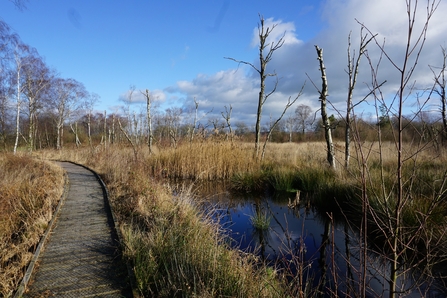
Peatlands like Foulshaw Moss Nature Reserve take millennia to develop © Tony Shaw
Gifting membership? Order by Wednesday 17 December in time for Christmas.

Peatlands like Foulshaw Moss Nature Reserve take millennia to develop © Tony Shaw
New analysis by The Wildlife Trusts has calculated the shocking impacts of extracting peat for use in horticulture.
The analysis estimates that across the UK as much as 31 million tonnes of CO2 could have been released into the atmosphere since 1990, as a direct result of using peat in gardening, and its use by professional growers of fruit, vegetables, and plants.
The campaign to stop peat extraction took off in the 1990s but only now are the UK and Welsh Governments conducting a public consultation on ending the use of peat in the retail sector in England and Wales by 2024.
The Wildlife Trusts believe we cannot wait this long and are calling for an immediate ban on the sale and extraction of peat for horticulture, and a ban on importing peat from abroad.
Despite thirty years of campaigning against extraction and increased public outcry, peat continues to be sold in vast quantities for amateur and professional horticultural use, with huge consequences for nature and climate.
Industry progress towards peat-free alternatives has been slow and inconsistent, and between 2018-19 peat consumption in the UK declined by just 2.3%, before rapidly increasing by 9% as lockdown drove more people to buy compost for gardening.
On average, annual UK peat sales would fill 29,000 large shipping containers and could release up to 850,000 tonnes of CO2 .
In 2020 alone, nearly 900,000 cubic metres of peat were extracted from UK soils, with a further 1.4 million cubic metres of peat imported from Ireland and the rest of Europe. A total of just over 2.29 million cubic metres of peat were dug up to be sold in the UK market in 2020, with a small quantity also being exported to other countries.
If peat is left undisturbed – in bogs, not bags – this quantity of peat could have stored approximately 238,000 tonnes of carbon for millennia to come. However, once peatland habitats are disturbed for extraction, stored carbon becomes carbon dioxide (CO2) and is lost to the atmosphere forever, contributing directly to climate change.
David Harpley, Conservation Manager for Cumbria Wildlife Trust, said:
“Nationwide, the losses of peatland are huge and irrecoverable. Once a peatland is gone, it’s gone. Tragically these beautiful places are disappearing as peat is extracted and stuck in compost bags. As well as destroying important habitat for wildlife, this process also releases carbon into the atmosphere, accelerating climate change.
“Peatbogs are vitally important habitats that take millennia to develop but over the centuries, they have been degraded by many means, including drainage, heavy grazing, regular burning, cultivation and forestry. Our survey of bogs in the Lake District confirmed that most are in a damaged state. Since 2001 we’ve been restoring these precious habitats. We're reversing damage to bare peat areas by covering them with vegetation, blocking drains to re-wet the landscape and reintroducing sphagnum mosses.”
David describes one particularly successful peatland restoration project, at Foulshaw Moss Nature Reserve near Witherslack.
“In the past, this lowland raised bog had been damaged by peat cutting and the planting of conifers, which drained it and dried it out. Since we bought the land in 1999, we’ve carried out extensive work, blocking the drains and removing the invasive trees and plants. This has raised the water level of the peatland, and seasonal fluctuations are no longer causing it to degrade and release CO2 into the atmosphere. Over time, as the peatland recovers, it will begin to cover in sphagnum moss, which will take in CO2 as it decays very slowly and forms peat. We estimate that this area of restored peatland will lock in 5,392 tonnes of CO2 per year!
“This restored habitat now supports a wonderful array of wildlife: plants such as golden bog-moss, bog sedge and bog rosemary, and insects such as the large heath butterfly, argent and sable moth, bog bush cricket and 13 species of dragonfly. Birds found here include the tree pipit, stone chat, meadow pipit, reed bunting, skylark and grasshopper warbler. There are many reptiles and amphibians to be seen in summer months, including adder, slow worm, common lizard, palmate newt, common frog and common toad.
“So let’s save more of our precious peatlands, by keeping the peat in the ground. You can help by supporting The Wildlife Trusts’ call for an immediate ban on the sale and extraction of peat for horticulture. Let’s leave peat undisturbed – in bogs, not bags!”
The Wildlife Trusts are urging the public to respond to the Government consultation – it is open until 18th March 2022. The public are urged to take part in The Wildlife Trusts’ e-action here.
Does your local garden centre stock peat-free compost? If so let us know – we are creating a list of Cumbrian stockists who are offering peat-free alternatives to compost. Find out more.